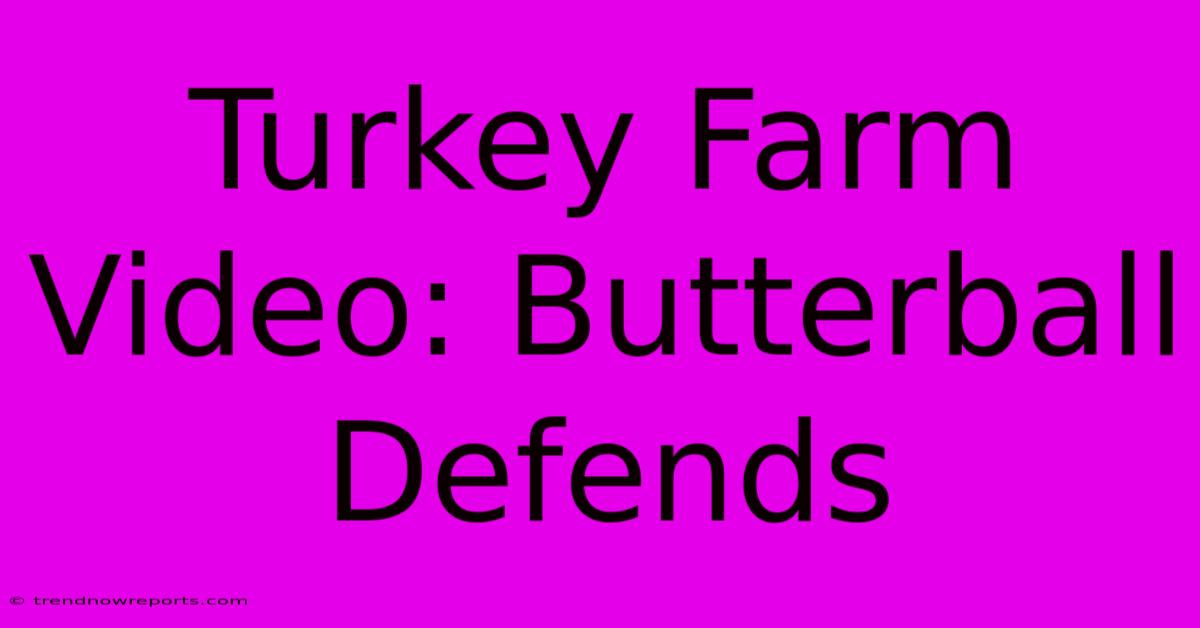Turkey Farm Video: Butterball Defends

Discover more detailed and exciting information on our website. Click the link below to start your adventure: Visit My Website. Don't miss out!
Table of Contents
Turkey Farm Video: Butterball Defends – A Farmer's Perspective
Okay, folks, let's talk turkeys. Specifically, that viral video that popped up a while back, showing, well, let's just say conditions at some turkey farms. I've been raising birds – mostly chickens, but some turkeys too – for over twenty years, and that video? It hit me hard. It really did. I know Butterball, a big name in the industry, got slammed, and rightfully so in some cases. But let me tell you, this ain't the whole story.
This isn't about excusing bad practices; it's about nuance. There’s a huge difference between a factory farm and a small-scale operation, even if both are raising Butterball turkeys. See, Butterball supplies birds to tons of different farms; they don't own them all. It's a complex supply chain, and it's tough to keep tabs on everyone, even for a giant like them.
My Experience with Turkey Farming
I started small, a few dozen birds in my backyard. Remember that? Cute, right? Then I expanded, learning along the way. I made mistakes – lots of them. One year, I had a serious outbreak of disease; lost nearly half my flock. Brutal. It taught me a lot about biosecurity and proper sanitation— stuff that's crucial, not just for the turkeys' health but also to make sure my farm remains profitable. That's something those big farms need to get right as well.
What the Butterball Video Missed
The video focused on the negative, which is understandable. Nobody wants to see birds suffering. But it lacked context, kinda like a news article with only one side of the story. It didn't show the massive investment many farms make in improving conditions. We're talking about things like better ventilation systems, improved flooring to minimize leg problems, and improved feed quality. These things cost money—a lot of money—and it's not always immediately obvious, but it leads to healthier, happier birds. You need data to back up these claims, so farms are increasingly adopting technology to track bird health and environmental conditions.
The Importance of Transparency
Butterball's response, while somewhat late in the game, highlighted the importance of transparency in the food industry. They're working to improve traceability and share more information about their practices. This is huge. Consumers need to know where their food comes from and how it's produced. We need more transparency, especially on the large scale.
I, for one, am working on better transparency. I offer tours of my farm, and I'm always open to questions. If people see the work and effort that goes into responsible farming, they might have a better understanding.
Tips for Consumers
What can you do? Firstly, ask questions! Look for farms and companies that prioritize animal welfare. Check their websites, look for certifications. Secondly, support local farmers whenever possible. Smaller farms tend to have better animal welfare practices, and they're more likely to be responsive to your concerns.
Finally, remember that videos, even viral ones, don't always tell the whole story. Do your research; don't just jump to conclusions. It’s easy to get swept up in emotional reactions, but responsible food production is really complicated.
This entire situation with the Butterball video highlights the need for a more nuanced conversation. It’s not a simple case of good versus evil, but rather a reflection of the complexities of modern food production. We need to keep pushing for better practices, for more transparency, and for a more responsible approach to how we raise our food.

Thank you for visiting our website wich cover about Turkey Farm Video: Butterball Defends. We hope the information provided has been useful to you. Feel free to contact us if you have any questions or need further assistance. See you next time and dont miss to bookmark.
Featured Posts
-
Elizabeth Line Service Disruption
Nov 27, 2024
-
Hellebuyck Leads Jets To 4 1 Win
Nov 27, 2024
-
Rayon V2 Launch Collaborative Cad
Nov 27, 2024
-
Dangerous Driving Cork Crash Victims Grief
Nov 27, 2024
-
Watch Slovan Bratislava Vs Milan Uefa
Nov 27, 2024
